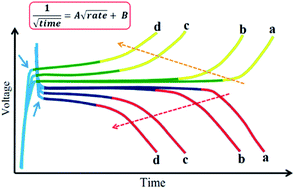Boundaries of charge–discharge curves of batteries†
Abstract
Understanding the underlying mechanisms of the charge–discharge behaviour of batteries, especially Li-ion and Na-ion intercalation ones, is obligatory to develop and design energy storage devices. The behaviour of the voltage–capacity/time (V–C/T) diagram is one of the most critical issues which should be understood. This paper aims to elucidate the boundaries of the charge–discharge V–C/T curves, i.e. their beginning and end arches. By reviewing the literature, it can be found that the shape of the beginning arch of the V–C/T curves under (dis)charge seems to remain almost unchanged upon changing some conditions such as charging or discharging, additives, morphologies, heat treatments, number of cycles, operation temperature, and even current rate. In contrast, the curves' end arch changes with the conditions. The phenomenon is explained based on the bipolarization of the cathode particles' mechanism. Influences of the current rate and particle size on the V–C/T curves are investigated. Accordingly, a general mathematical relationship is proposed here for the V–T curves' boundaries. The relationship is in good agreement with experimental data of various Li/Na-ion cathode materials (as case studies) taken from the literature for various conditions, cells, and cathode powders. Moreover, it is established that the relationship can predict (dis)charge time as a function of rate for both intercalation and conversion rechargeable batteries, including Li-ion, Na-ion, Li–S, Na–S, NiMH, and lead–acid batteries. It seems to be a key parameter to link various kinds of battery. The mechanism and its relative relationship provide new insights, and open new landscapes and evaluation fields for batteries' relevant characteristics, and help to understand, design, tune, control, and engineer behaviours.



 Please wait while we load your content...
Please wait while we load your content...